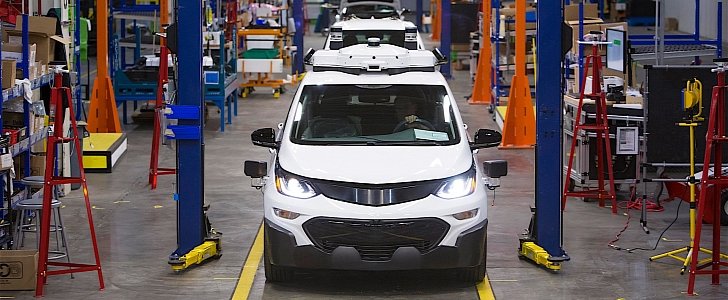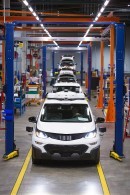General Motors has marked a new first in the autonomous vehicles, which came in the form of employing mass-production methods for self-driving automobiles.
It may not resemble a breakthrough, but it is significant because all other companies in the automotive industry have built exceptional prototypes for self-driving technology outside their regular production lines.
GM wants to set an example, and the first step was already made with a fleet of 130 Chevrolet Bolt units, which is scheduled to grow to 180 cars.
The first units rolled out of the Orion Assembly Plant in Michigan in January, and the one that completed the “batch” of 130 cars was built yesterday. Evidently, the entire production quota of the Bolt was higher than these cars, because dealers and customers had to receive their reserved units.
Chevrolet fitted the Bolt with LiDAR, a set of cameras, various sensors dedicated to this activity, and specially designed hardware and software to enable those components to work together to help the car avoid accidents and stay on the road.
GM wants to offer a reliable and safe autonomous vehicle that would not require a driver behind the wheel, but even the American corporation’s first step in this direction is just the beginning of a long journey with many obstacles.
Since June 2016, GM tested autonomous cars on public roads with its partners at Cruise Automation, and the trials have been expanded from San Francisco and Scottsdale to Warren, Michigan. The idea behind the expansion was to expose these vehicles to various road and traffic conditions, as well as different types of weather and climate.
One of the biggest challenges faced by companies that want to make self-driving cars possible is to develop a vehicle that can handle itself in harsh weather conditions, and not just in sunny weather. All of the sensors will have to be weather-proof, even though humans struggle to drive in particular conditions.
Other obstacles in this journey include legislation, the limits of human-designed technology, the development of Artificial Intelligence, and even the faith of people in computers, which will have to manage everything without a single error.
GM wants to set an example, and the first step was already made with a fleet of 130 Chevrolet Bolt units, which is scheduled to grow to 180 cars.
The first units rolled out of the Orion Assembly Plant in Michigan in January, and the one that completed the “batch” of 130 cars was built yesterday. Evidently, the entire production quota of the Bolt was higher than these cars, because dealers and customers had to receive their reserved units.
Chevrolet fitted the Bolt with LiDAR, a set of cameras, various sensors dedicated to this activity, and specially designed hardware and software to enable those components to work together to help the car avoid accidents and stay on the road.
GM wants to offer a reliable and safe autonomous vehicle that would not require a driver behind the wheel, but even the American corporation’s first step in this direction is just the beginning of a long journey with many obstacles.
Since June 2016, GM tested autonomous cars on public roads with its partners at Cruise Automation, and the trials have been expanded from San Francisco and Scottsdale to Warren, Michigan. The idea behind the expansion was to expose these vehicles to various road and traffic conditions, as well as different types of weather and climate.
One of the biggest challenges faced by companies that want to make self-driving cars possible is to develop a vehicle that can handle itself in harsh weather conditions, and not just in sunny weather. All of the sensors will have to be weather-proof, even though humans struggle to drive in particular conditions.
Other obstacles in this journey include legislation, the limits of human-designed technology, the development of Artificial Intelligence, and even the faith of people in computers, which will have to manage everything without a single error.






